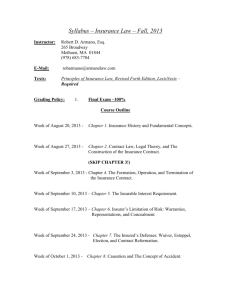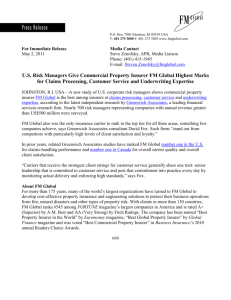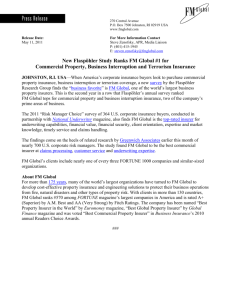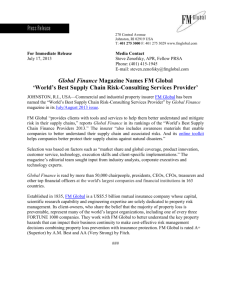Financial Management
advertisement
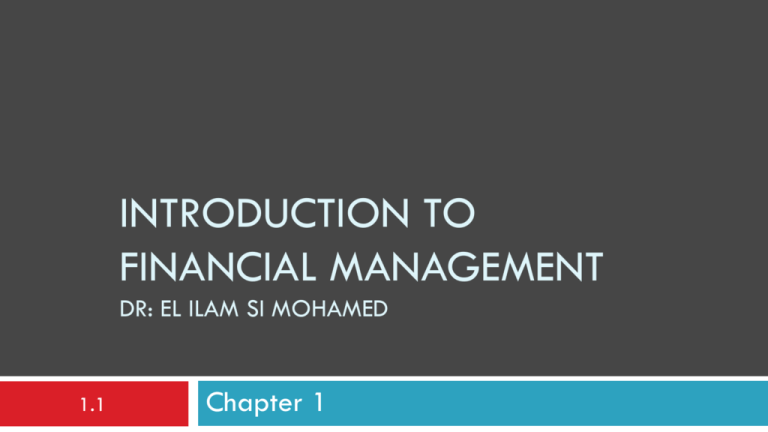
INTRODUCTION TO FINANCIAL MANAGEMENT DR: EL ILAM SI MOHAMED 1.1 Chapter 1 Key Concepts and Skills 1.2 Know the basic types of financial management decisions and the role of the financial manager Know the goal of financial management Know the financial implications of the different forms of business organization Understand the conflicts of interest that can arise between owners and managers Chapter Outline 1.3 Finance: A Quick Look Business Finance and The Financial Manager Forms of Business Organization The Goal of Financial Management The Agency Problem and Control of the Corporation Financial Markets and the Corporation Basic Areas Of Finance 1.4 • • • • Corporate finance Investments Financial institutions International finance Investments 1.5 • • • Work with financial assets such as stocks and bonds Value of financial assets, risk versus return and asset allocation Job opportunities • • • Stockbroker or financial advisor Portfolio manager Security analyst Financial Institutions 1.6 Companies that specialize in financial matters Banks – commercial and investment, credit unions, savings and loans Insurance companies Brokerage firms Job opportunities International Finance 1.7 This is an area of specialization among all of the areas discussed so far It may allow you to work in other countries or at least travel on a regular basis Need to be familiar with exchange rates and political risk Need to understand the customs of other countries and speaking a foreign language fluently is also helpful Why Study Finance? 1.8 Marketing Accounting Dual accounting and finance function, preparation of financial statements Management Budgets, marketing research, marketing financial products Strategic thinking, job performance and profitability Personal finance Budgeting, retirement planning, college planning, day-to-day cash flow issues Business Finance 1.9 Some important questions that are answered using finance What long-term investments should the firm take on? Where will we get the long-term financing to pay for the investment? How will we manage the everyday financial activities of the firm? Financial Manager 1.10 Financial managers try to answer some or all of these questions The top financial manager within a firm is usually the Chief Financial Officer (CFO) Treasurer – oversees cash management, credit management, capital expenditures and financial planning Controller – oversees taxes, cost accounting, financial accounting and data processing Financial Management Decisions 1.11 Capital budgeting What long-term investments or projects should the business take on? Capital structure How should we pay for our assets? Should we use debt or equity? Working capital management How do we manage the day-to-day finances of the firm? Forms of Organization 1.12 Three major forms in the united states Sole proprietorship Partnership General Limited Corporation S-Corp Limited liability company Sole Proprietorship Advantages Easiest to start Least regulated Single owner keeps all the profits Taxed once as personal income 1.13 Disadvantages Limited to life of owner Equity capital limited to owner’s personal wealth Unlimited liability Difficult to sell ownership interest Partnership Advantages Two or more owners More capital available Relatively easy to start Income taxed once as personal income Disadvantages Unlimited liability General partnership Limited partnership Partnership dissolves when one partner dies or wishes to sell Difficult to transfer ownership 1.14 Corporation Advantages Limited liability Unlimited life Separation of ownership and management Transfer of ownership is easy Easier to raise capital 1.15 Disadvantages Separation of ownership and management Double taxation (income taxed at the corporate rate and then dividends taxed at personal rate) Goal Of Financial Management 1.16 What should be the goal of a corporation? Maximize profit? Minimize costs? Maximize market share? Maximize the current value of the company’s stock? Does this mean we should do anything and everything to maximize owner wealth? The Agency Problem 1.17 Agency relationship Principal hires an agent to represent their interest Stockholders (principals) hire managers (agents) to run the company Agency problem Conflict of interest between principal and agent Management goals and agency costs Managing Managers 1.18 Managerial compensation Incentives can be used to align management and stockholder interests The incentives need to be structured carefully to make sure that they achieve their goal Corporate control The threat of a takeover may result in better management Other stakeholders Work the Web Example 1.19 The Internet provides a wealth of information about individual companies One excellent site is finance.yahoo.com Click on the web surfer to go to the site, choose a company and see what information you can find! Figure 1.2 1.20 Financial Markets 1.21 Cash flows to the firm Primary vs. secondary markets Dealer vs. auction markets Listed vs. over the counter securities NYSE NASDAQ Quick Quiz 1.22 What are the four basic areas of finance? What are the three types of financial management decisions and what questions are they designed to answer? What are the three major forms of business organization? What is the goal of financial management? What are agency problems and why do they exist within a corporation? Definitions and concepts Dr: EL ILAM SI MOHAMED Financial management, sometimes called financial operations or finance, is how an insurance company manages its resources to meet the company’s financial goals, especially the overall goals of solvency and profitability. Organization of Financial Management Investment Committee Board of Directors Audit Committee Board of Directors Chief Financial Officer Financial Operations Chief Investment Officer Investment Operations Treasurer Treasury Operations Controller Accounting and Financial Reporting Chief Auditor Audit and Internal Control Accounting and Financial Operations Accounting is a system or set of rules and methods for collecting, recording, analyzing, summarizing, and reporting financial information. Financial reporting is the process of presenting financial data about a company’s financial position. Operating performance, and flow of funds into and out of the company. In most of the insurance companies, the controller or comptroller is the head of accounting and financial reporting Accounting and Financial Operations The primary responsibilities of the accounting and financial reporting function are to : Record, track and report on financial transactions Coordinate the budget process and oversee expense analysis Prepare financial statements and reports for external stakeholders Gather, record ,analyze and distribute financial information to company mangers Treasury Operations Treasury Operations, manages the cash coming into and out of a company The treasurer oversees the maintenance and management of records and reports for all of an insurer’s cash transactions Treasury Operations Treasuery operations include the following responsibilities: Cash Management-Oversees cash receipts and approves cash disbursements Bank relations and account administration- Set up bank accounts, reconciles bank statements Bank reconciliation-Records cash transactions and charges them to proper accounts Short term credit activities- invests excess cash in very short – term arrangements and arranges for very short term borrowing as needed Investment Operations Investments are core insurance company operation. Typically, a CIO manages investment operations. The CIO is responsible for : Making recommendations to the board and implementing board directives Ensuring investment decisions are in line with investment policy and regulatory requirements Communicating to the accounting and actuarial areas the current and expected rates of return on the company’s Audit and Internal Control By conducting audits of its financial and operational business activities , an insurer can objectively , and compliance with evaluate its operating procedures, management efficiency and compliance with specified rules and regulations Audit and Internal Control The ongoing duties of an insurer’s audit committee include: Monitoring internal controls for financial operations Supervising and meeting with internal auditors to discuss their activities and findings Monitoring organizational activities to improve operating efficiencies Reporting the committee’s activities to the board of directors Responsibilities of Financial Management (1) Setting Financial strategy (2) Managing risk (3) Managing the company’s solvency and profitability (4) Managing capital (5) Managing cash flows (6) Providing financial information to stakeholders 1) Setting Financial Strategy Financial strategies may be categorized as : 1) Aggressive 2) Conservative 3) combination of the above two Aggressive : A company that places a strong emphasis on taking risks that could enhance its profitability. For e.g. investing in relatively high- risk assets, developing many new and unusual products, implementing new distribution systems Conservative Financial Strategy: An insurer that places a strong emphasis on avoiding risks that could threaten its solvency 2) Managing Risks Risk is the possibility that an investment might have an unexpected result. Common types of risks: Investment risk- is the possibility that an investor will fail to earn some or all of an expected return or will lose all or part of the original investment. Some important risks associated with investing are Market Risk : For e.g. real estate investment may lose value if the real estate market as a whole declines Interest-rate risk: For e.g. if the interest rate increase, bonds tend to lose market value Default-risk: The risk that a borrower will fail to repay the debt Liquidity –risk: for e.g. I the owner of property, such as shopping mall, should suddenly need cash quickly, the property may have to be sold for a price less than its true value 2) Managing Risks Operational Risk is a broad category of risks originating from inadequacies in an insurer’s operational areas or from external events affecting an insurer's operational areas. Two major types of operational risks are: Business process risk- For e.g. inefficient customer service processes might create long TAT Event Risk: For e.g. an earthquake might result in technology failures and an inability to run the business Product Risk : is the risk that a company’s [products might not sell as well or be as profitable as expected A) Pricing risk: For e.g. more insured might die than an insurer anticipated when pricing a life insurance product, so claims will be higher 2) Managing Risks Risk management is the process of systematically identifying, assessing, and minimizing the negative impact of risk. To minimize the negative impact of these various risk across the organization, most insurers practice Enterprise Risk Management. ERM is a system that identifies and quantifies risks both from potential threats and potential opportunities and manages them. 3) Managing Solvency and Profitability The dual goals of financial management are to (1) protect solvency (2) increase profitability Pursuing profitability requires a certain amount of risk taking, whereas protecting solvency involves risk avoidance and stability Long term profitability enables an insurer to A) Provide funds for investments B) Pay policy dividends C) Pay cash dividends to stockholders and increase the attractiveness of the company’s stock to investors D) Generate high-quality ratings from insurance rating agencies E) Provide funds to develop products, expand product lines, for company expansion e.t.c 4) Managing Capital Financial managers attempt to increase the probability that the company will remain financially healthy by using the company’s capital appropriately Capital= Assets – Liabilities Benefits to an insurer of maintaining the strong capital position include: Greater ability to withstand difficult conditions such as bad economy Greater flexibility in its operations Greater ability to raise capital on favorable terms Ways to Raise Capital? Ways to Use Capital? 5) Managing Cash Flows A cash flow is any movement of cash into or out of an organization A cash inflows include- 1) revenues from product sales 2) investment income 3) sales of existing assets 4) external financing A Cash outflow includes 1) payments to policy owners and beneficiaries 2) payment for operating expenses 3) purchase of new assets The basic goal for managing cash flows is to have enough assets available so that the insurer can pay its obligations as they come due and to invest the remaining assets wisely to earn favorable returns 6) Providing financial information to stakeholders Insurers provide information to stakeholders in the form of Financial statements Annual report Annual statements 6) Providing financial information to stakeholders A financial statement is a summary of a company’s financial condition on a specified date or its performance during a specified period. Two key financial statements are the income statement and the balance sheet The income statement shows a company’s revenues and expenses during a defined period, such as one quarter or one year, and shows weather the company experienced a profit or loss during that period. Revenues are amounts that a company earns from its business operations Expenses are amounts that a company spends to support its business operations The income statement also shows net income, which is calculated by subtracting expenses from revenues 6) Providing financial information to stakeholders Balance sheet, which lists the value of an insurer’s assets ,liabilities , and capital and surplus as of a specified date Annual Report is a financial document that an incorporated business issues to its stakeholders and other interested parties to report the business’s activities and financial performance for the preceding year. Annual Statement
